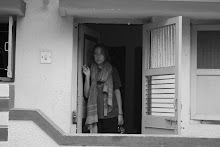There are two doors.
Behind one is a Western toilet; behind the other is an Indian squat toilet.
But I’m getting ahead of myself.
To begin with, you should know that I’ve adjusted to a relatively typical life in Bhuj. I spend Monday through Saturday at the office managing both projects and the 115 degree heat; I buy groceries from a store competing in ‘Who Can Cram the Most Items into the Smallest Spaces’*; I go watch Bollywood movies in Hindi, munching on twenty cent masala popcorn. Life here feels part social experiment, part feel-good movie, and part abnormally normal.
Mostly abnormally normal, though.
Because I embrace the idea, ‘Don’t cling to comfort and everything will be comfortable.’ In a less Taoist form, this translates into my current adjustment approach:
a. Don’t assume anything will be like it is at home (because it won’t)
b. Never be in a hurry (because nothing will happen as quickly or efficiently as you’re used to)
c. Form relationships (they are the foundation of everything here)
d. Learn the language (and use it)
a. Don’t assume anything will be like it is at home (because it won’t)
b. Never be in a hurry (because nothing will happen as quickly or efficiently as you’re used to)
c. Form relationships (they are the foundation of everything here)
d. Learn the language (and use it)
e. Say ‘yes’ (unless you really shouldn’t) 
And maybe also:

Yet, adjustment is only half the battle of living and working abroad. The second part is harder: assimilation.
Which brings me to the doors.
 |
| The Choice |
They’re located in my office. Every day, I have to choose between the Indian and Western toilet. Despite the fact that this choice may seem easy to you, the overt symbolism of the situation is almost preposterous. It’s a tangible manifestation of the questions I’m continually asking myself: How much of my “Americanness” do I let go of? How much “Indianness” do I take on? These questions arise because when you’re thrown into an entirely different culture, you realize just how much of yourself is a result of growing up in the place, the society that you did. It goes beyond choosing between Indian preferences and American partialities. To assimilate is to question your identity. To determine which aspects of yourself you can shed for the better and which aspects are here to stay (even if they’re not culturally apt). It’s like an identity detox.
But anyways. About those toilets.
The decision is indeed expectedly easy; I just didn’t expect my choice. Still recovering from my ashram toilet aversion (see A Day in Orientation), I was so excited when I discovered the Western toilet here. Yet as it turns out, I haven’t wanted to use the American side since about week three. Which goes to show I need to add a platitude to my adjustment approach:
f. Expect the unexpected
g. Must you always elevate mundane things into something symbolic of your Indian experience?
* If I fortuitously take my gaze towards the right hand corner of the second shelf from the top on the third aisle of the store in between the bag of lentils and the jar of pineapple jam, I’ll find a luxury item like Oreos.

I do not subscribe to the myth of the expatriate, who elevates everything foreign to the sublime, but in the case of the toilet, the preference is indeed an easy one. After you've been squatting for a while, you realize it's the Western toilet -- and its shared seating space of skin-smeared and feces-flecked porcelain -- that is the gross one. Give me a hole in the ground any day.
ReplyDelete